Top>Education>Math for seating arrangements
 Index
Index
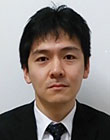
Tetsuya Terado [profile]
Math for seating arrangements
Tetsuya Terado
Teacher, Mathematics Department, Chuo University Yokohama Junior & Senior High School
Area of Specialization: Machine Learning Theory
As a form of playing with mathematics in my class, I suggest that students use mathematics to change the seating arrangement. Normally, seats are changed by having students drawing lots. However, in this article, I will introduce a method for changing the seating arrangement using simple calculations which can be performed by anyone. This method contains several elements which spark the interest of students, thus creating an impetus for further learning in mathematics.
Seating arrangement without drawing lots
In this article, let’s consider changing the seating arrangement for a class of 32 students. I will start by writing all numbers from 1 to 32 on the blackboard and then having each student take turns selecting one of the numbers. I erase each number as it is chosen. This process ensures that each student selects a different number from 1 to 32. Finally, I instruct students to multiply their selected number by 52 and then to divide it by 33 in order to find the remainder. This remainder indicates the number of the new seat. This completes the seat changing process.
(*Each seat is assigned a number (1, 2, 3…) in advance starting from the front seat closest to the door.)
For example, if a student selects the number 5: 5 × 52 = 260, 260 ÷ 33 = 7 with a remainder of 29. Therefore, the number 29 is that student’s new seat number.
In the method used above, for a class of 32 students, the divisor is fixed at 33. Using this divisor ensures that a remainder of 1 to 32 will be generated by division. Generally speaking, the divisor equals the “number of students + 1.” On the other hand, the multiplier of 52 is not a fixed factor. This number may be another number, and it is uncertain data for the students when they select a number from the blackboard in the first part of the exercise.
However, this does not mean that any number can be used for the multiplier. Changing the seating arrangement will fail if multiple students end up with the same remainder. In order to complete changing the seating arrangement, it is necessary for all remainders to be different.
To make a long story short, the divisor of 33 and the multiplier A must be selected so that A and 33 are coprime (the greatest common divisor of A and 33 is 1).
Many possible explanations can be given for a successful change of seating arrangement using this formula. However, in order to make the exercise as enjoyable as possible for students, I explain using “drawing a traversable star (drawing a star without lifting your pencil from the paper).”
Drawing a traversable star
Q. Is it possible to draw a traversable star?
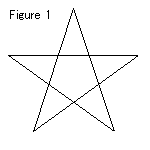
In response to this question, almost all students will draw a star like the one shown in Figure 1.
As shown in Figure 2, numbers can be allocated to each apex of a regular pentagon, and the star can be drawing a line to connect the points in the order of 0→2→4→1→3→0.
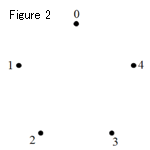
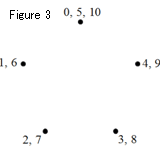
Furthermore, when allocating numbers as shown in Figure 3 (0, 5 and 10 indicate the same point), the path for drawing a traversable star becomes 0→2→4→6→8→10. This depicts a numeric string formed by adding “2” to “0” a total of five times.
The numbers for apices in Figure 3 are allocated in the order of “1, 2, 3, 4…10” started from apex 0 and moving counterclockwise. This makes it easier to understand the regularity of stroke order. This also means that multiple numbers are allocated to a single apex. For example, when considering the apices of Figure 3, “0 = 5 = 10,” “1 = 6,” “2 = 7,” “3 = 8,” and “4 = 9” all hold true. All of these numbers connected by an equal sign produce the same reminder when divided by 5.
In other words, for the stroke order of 0→2→4→6→8→10 shown in Figure 3, when dividing each number by 5, the remainder is equal to the stroke order of 0→2→4→1→3→0 shown in Figure 2.
Next, the same way of thinking is applied to a traversable star with apices of a regular octagon. Numbers are allocated to apices of the octagon as shown in Figure 4.
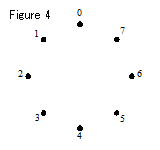
Similar to the regular pentagon discussed above, the numeric string is formed by adding “2” to “0” a total of eight times: 0→2→4→6→8→10→12→14→16→18.
Dividing each of these numbers by 8 produces remainders as follows: 0→2→4→6→0→0→2→4→6→0. As shown in Figure 5, it is not possible to draw a traversable star when connecting the apices in this order.
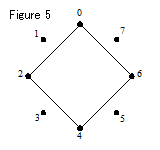
To continue, let’s create a numeric string by adding “3” to “0” a total of eight times: 0→3→6→9→12→15→18→21→24.
Dividing each of these numbers by 8 produces the following remainders: 0→3→6→1→4→7→2→5→0.
As shown in Figure 6, a traversable star can be drawn by connecting the apices in this order.
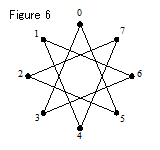
The failed stroke order introduced in Figure 5 contains a “0” in the middle of the string. When drawing a traversable star, it is necessary to return to apex 0 only after passing through all other apices exactly one time. Accordingly, “0” must not appear in the string until returning to apex 0 on the final stroke. Therefore, when a numeric string is formed by adding “N” to “0” a total of eight times (0→N→N2→N3→N4→N5→N6→N7→N8), it is necessary to select N so that N, 2N…7N cannot be divided by 8 with no remainder.
The “N” fulfilling this condition is a number which is a coprime of 8. For example, N=1, N=3, N=5, N=7, N=9, N=11, N=13, and N=15 are coprimes of 8, so a traversable star can be drawn successfully when using these values for N.
Application
Now, let’s try drawing a traversable star by connecting the apices of a regular star with 33 apices, which possesses the same structure as change of seating arrangement for a class of 32 students as described above. For a numeric string formed by adding “N” to “0” a total of thirty-three times (0→N→2N→3N→4N→5N…→31N→32N→33N), the following values are calculated when using N=52 (52 and 33 are coprimes): 0→52→104→156→208→260…→1612→1664→1716. Dividing each of these values by 33 results in the following remainders: 0→19→5→24→10→29…→28→14→0. Connecting the apices indicated by these remainders creates the traversable start shown in Figure 7.
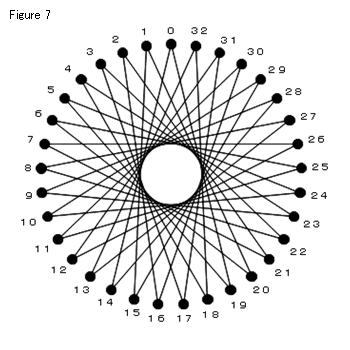
In the initial example of changing the seating arrangement, the student selecting the number “5” is assigned the new seat “29.” When looking at Figure 7, you can see that the fifth stroke of the traversable star connects with apex 29. This traversable star visually expresses how different remainders are generated in calculation of changing the seating arrangement. It also shows the rule governing the transition of the number which was originally selected by the student.
Regularity and students’ motives
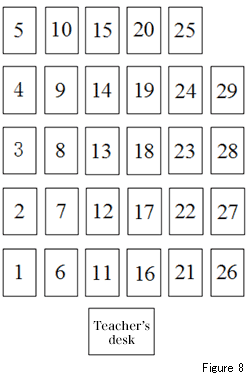
Unlike drawing lots, this change of seating arrangement using mathematics does not generate a random result. Instead, it possesses clear regularity. However, since students only learn the divisor after selecting a number, it seems that they are not capable of choosing their own seat through contrivance. However, in some conditions, seating arrangement may follow the wishes of students to a certain extent.
For example, when changing the seating arrangement for a class of 29 students, the final divisor is 30. In this case, regardless of what number is used for the divisor, the student who selected number “15” will always produce a remainder of 15. Furthermore, students selecting numbers which are multiple number of 5 will always produce remainders which are multiple number of 5. This occurs because the divisor of “30” contains aliquots of 5 and 15.
Generally speaking, for the number “A” selected by the student and the divisor “P,” for the greatest common divisor of “D,” the student selecting “A” will be assigned a seat which is a multiple number of “D.”
Therefore, in the case of the student who selected “15,” since the greatest common divisor of the selected “15” and the divisor “30” is 15, the student will be assigned at seat which is a multiple number of 15. Moreover, since the only multiple number of 15 among the numbers 1 and 29 is 15, the student who selected “15” will be assigned the seat number 15.
If classroom seats are arranged as shown in Figure 8, students who want to sit in back of the class should select the numbers 5, 10, 15, 20 or 25.
Preventing contrived selection of seats
There is the possibility of intelligent students discovering the decisive regularity discussed above and contriving to select their new seat. The following method can be used to prevent such contrivance.
Consider the example of changing the seating arrangement for a class of 29 students. Normally, students would select one number from 1 to 29, multiply the selected number by a certain value, divide by 30 and take the remainder. Instead, this method is changed to one in which students select one number from 1 to 30, multiply the selected number by a certain value, divide by 31 and take the remainder. When using the latter method, there is a high probability that one student will calculate a final remainder of 30. However, since actual seats are numbered from 1 to 29, the assignment of a seat for the student with a remainder of 30 is temporarily deferred until seats have been assigned to the other 28 students. Finally, the student with a remainder of 30 is assigned to the remaining seat.
The objective of this method is to change the divisor from 30 to 31. Since the number 30 possesses many divisors, contrivance is easy. However, since 31 is a prime number, using 31 as a divisor eliminates the decisive regularity of changing the seating arrangement and makes contrivance impossible.
Gaining from using math for seat arrangements
The objective of changing the seating arrangement explained in this article is more than to simply provide an easy way to change seats. Instead, I hope that students will take the initiative to question and explore the mathematical properties hidden within the method.
As discussed earlier, this method of change of the seating arrangement creates decisive regularity corresponding to the number of factors for the divisor. This regularity is by no means a difficult concept, and students who give sufficient thought to the method of changing the seating arrangement are sure to realize how it works. Those students will then be able to contrive to get the seats which they want at the time of the next change. In the previous section, I introduced a method for preventing contrived selection of seats. However, rather than implementing this method immediately, it is interesting to watch how students respond for the time being.
“Using mathematics to change the seating arrangement” and “drawing a traversable star” possess the same mathematical properties. These methods can also be used as examples of modular arithmetic which is studied in high school and cyclic groups which are studied at university. By ultimately linking these exercises to content introduced in textbooks, it is possible to promote a high level of understanding among students.
-
Tetsuya Terado
Teacher, Mathematics Department, Chuo University Yokohama Junior & Senior High School
Area of Specialization: Machine Learning Theory - Tetsuya Terado was born in 1986 in Tokyo.
In 2009, he graduated from the Division of Mathematical Sciences, School of Science and Engineering in the Tokyo Metropolitan University Faculty of Urban Liberal Arts.
In 2011, he completed the Master’s Program in the Tokyo Metropolitan University Graduate School of Science and Engineering.
After serving as Full-Time Instructor of mathematics at a private school in Chiba Prefecture for 3 years, he assumed his current position in 2014.
The theme of his master’s thesis was “Inductive inference of language with weak characteristic sets.”
- Research Activities as a Member of Research Fellowship for Young Scientists (DC1), Japan Society for the Promotion of Science (JSPS) Shuma Tsurumi
- Important Factors for Innovation in Payment Services Nobuhiko Sugiura
- Beyond the Concepts of Fellow Citizens and Foreigners— To Achieve SDGs Goal 10 “Reduce Inequality Within and Among Countries” Rika Lee
- Diary of Struggles in Cambodia Fumie Fukuoka
- How Can We Measure Learning Ability?
—Analysis of a Competency Self-Assessment Questionnaire— Yu Saito / Yoko Neha - The Making of the Movie Kirakira Megane








